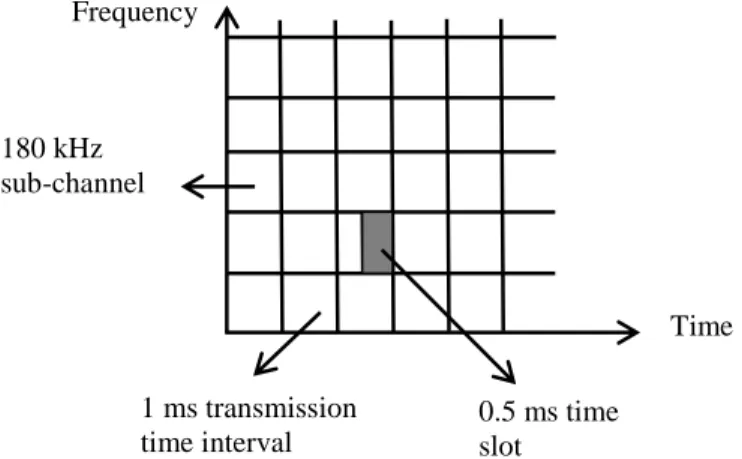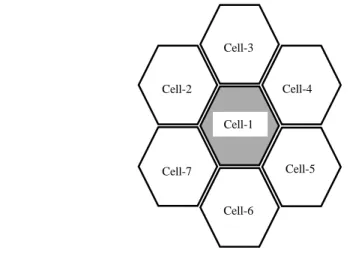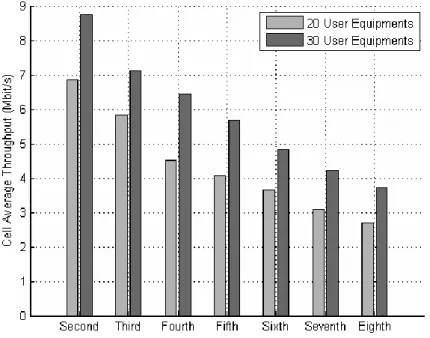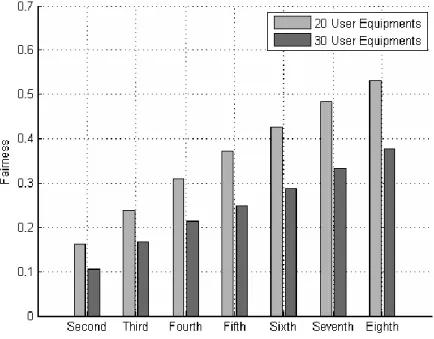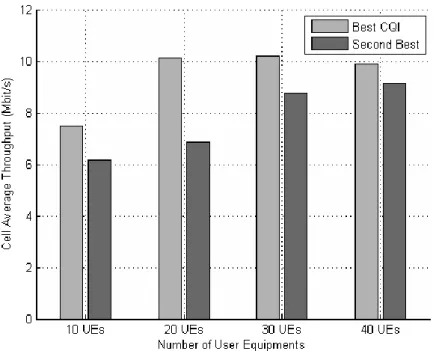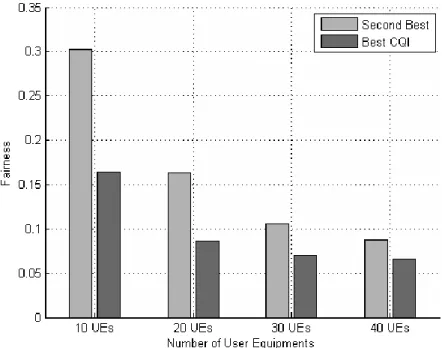Commun. Fac. Sci. Univ. Ank. Series A2-A3 V.56(1-2) pp 1-13 (2014)
PERFORMANCE EVALUATION OF A DOWNLINK PACKET SCHEDULING ALGORITHM FOR THE LONG TERM EVOLUTION
CELLULAR SYSTEMS
AYKUT KALAYCIOĞLU
Ankara University, Faculty of Engineering, Electrical-Electronics Engineering Department, 06830-Gölbaşı-Ankara-TURKEY
E-mail : aykut.kalaycioglu@ankara.edu.tr
(Received April16, 201; Accepted July 7, 2014)
ABSTRACT
Long Term Evolution (LTE) is the starting point towards the 4th generation (4G) of cellular
systems to increase the capacity, spectral efficiency and the coverage. One of the most important features of LTE is employing the radio resource management in order to improve the performance of the cellular system. In this study, performance evaluation of a downlink packet scheduling algorithm that depends on the channel quality information in the LTE cellular networks is discussed. Simulation results show that the analyzed downlink packet scheduling algorithm improves the fair resource allocation with a tolerable loss in the throughput.
KEYWORDS: Long Term Evolution, LTE, 4th Generation, 4G, packet scheduling.
1. INTRODUCTION
The multimedia applications, such as video streaming, online gaming and voice over IP (VoIP) have been dominating the wireless mobile network traffic nowadays. Besides, it is expected that more than 5 billion of broadband users will be mobile users by 2016 and probably served by the LTE/LTE-Advanced networks [1]. LTE, also commercially known as 4G for marketing reasons, is one of the latest standards specified by the Third Generation Partnership Project (3GPP) in order to meet the requirements of this tremendous growth of data traffic by providing high data rates, flexible spectrum and increased coverage with higher mobility [2].
3GPP LTE is simply an improvement from circuit switched network to an all-IP packet-based system, which is aimed to support real-time multimedia applications. LTE design targets can be summarized as peak data rates of 100 Mbps for downlink and 50 Mbps for uplink within a flexible spectrum ranging from 1.4MHz up to 20MHz bandwidth values, two times better spectral efficiency than 3G systems, decreased latency and support for very high user speeds of up to 350 km/h [3].
2
In order to meet the design requirements of the 3GPP, LTE exploits the advantages of both traditional and innovative technologies, such as Orthogonal Frequency Division Multiplexing (OFDM), Adaptive Modulation and channel Coding (AMC), and Orthogonal Frequency Division Multiple Access (OFDMA). OFDM, in which information bits are transmitted to receiver in packets with different subcarriers, is one of the most effective ways of combating the degrading effects of multipath and fading in wireless communication systems. Besides, OFDMA provides multiuser diversity and flexibility in scheduling radio resources by allowing several users to share the OFDM subcarriers at the same time in LTE networks [4].
All data and signaling traffic needs to be scheduled in LTE systems. The scheduling mechanism generally depends on the characteristics of the type of traffic, system requirements, and channel conditions. Although the scheduling scheme for LTE networks is not standardized, a radio resource management is required to regulate the packet scheduling operation. The Channel Quality Indicator (CQI) reporting with AMC mechanism are among the most important parts of a resource management process in order to both increase the system throughput and provide a fair resource allocation approach in LTE networks [3].
Several scheduling algorithms have been extensively studied in the literature [4-15] in order to meet the different design requirements. For example, exponential rule (EXP) [5], exponential proportional fair (EXP/PF) [6], and modified largest weighted delay first (M-LWDF) [15] are popular algorithms that have been proposed to schedule multimedia traffic in LTE networks. Besides, the round robin [12] is a very well-known scheduling algorithm in which the radio resources are assigned to each user in equal portions in a circular fashion. Round robin scheduling method is widely used in modern cellular systems due to its ease of implementation. Since the round robin scheduling algorithm provides a fair distribution at the expense of degradation in the system throughput, Best-CQI scheduling algorithm [14], on the other hand, maximizes the system throughput by allocating radio resources to the users having the best channel conditions. Thus, the user with the highest CQI value allows the AMC unit to select the optimum modulation order and channel coding ratio trying to maximize supported system throughput. However, the resource allocation is performed in a very unfair manner since the users experiencing bad channel conditions do not have the chance to be served. Thus, schedulers in LTE networks should maintain a tradeoff between throughput and fairness.
LTE network is a wireless communication system that is characterized as a multipath time varying environment, which produces both time and frequency dispersion. Therefore, the scheduler that should be used in LTE networks must consider the channel conditions in order to perform an efficient resource allocation. Using CQI reporting for the resource allocation is one of the most well-known
PERFORMANCE EVALUATION OF A DOWNLINK PACKET SCHEDULING ALGORITHM 3
channel-aware scheduling policies that exploit the channel conditions for the resource allocation.
In this study, performance evaluation of a modified downlink packet scheduling algorithm that depends on the channel quality information in the LTE cellular networks is discussed. The analyzed scheduling algorithm is similar to the well-known Best-CQI algorithm. However, in the discussed scheduler, the radio resources are distributed among the users in a manner to provide a tradeoff between fairness and system throughput. Basically, the analyzed scheduling algorithm now does not allocate the radio resources to the users that have the highest CQI value. Instead, the algorithm will assign the users with having less CQI values than the user with having the maximum CQI value. Consequently, there will not be a massive degradation in the throughput by the analyzed scheduler whereas a worthwhile increase in the fairness value will be achieved. Besides, the probability of allocating the radio resources to a same user that is constantly having good channel conditions will be reduced.
The rest of this paper is organized as follows. An overview of the important aspects of LTE system is briefly given in section 2. Scheduling mechanism and the analyzed scheduling algorithms are discussed in section 3. Finally, simulation results are presented in section 4 and the conclusions are given in section 5.
2. LONG TERM EVOLUTION SYSTEM: AN OVERVIEW
We summarize the main aspects of a Long Term Evolution cellular network within this section.
LTE can be described as an enhancement of the existing 3G systems with higher data rates, lower latencies and more efficient radio access. LTE network consists of evolved Node B (eNB) and user equipment (UE) nodes, which can be considered as base stations and mobile stations, respectively. LTE downlink radio transmission is based on OFDM and OFDMA which are the effective ways of combating the degrading effects of fading channels and providing flexibility in scheduling radio resources, respectively. The OFDM parameters such as length of frame, duration of a cyclic prefix and the number of OFDM symbols in each sub-frame are defined in the 3GPP standards [2].
Long Term Evolution physical resources can be represented as a time-frequency resource grid as shown in Figure 1. In the time domain, radio resources are distributed in a transmission time interval (TTI) with duration of 1 ms and each TTI has two 0.5 ms time slots. There are six or seven OFDM symbols in each time slot depending on the normal or extended cyclic prefix cases. There are 12 consecutive and equally spaced sub-carriers each have a bandwidth of 15 kHz in the frequency domain. A resource block (RB) can be defined as the smallest resource unit that can be assigned to user equipment in LTE network. It is composed of two
4
time slots of 0.5 ms length and one sub-channel of 180 kHz bandwidth in the time and frequency domains, respectively [3].
Figure 1. LTE time-frequency resource grid
As stated before, 1.4 MHz, 3 MHz, 5 MHz, 10 MHz, 15 MHz and 20 MHz transmission bandwidths are supported in LTE networks. Since LTE provides several different transmission bandwidths and the sub-channel size is fixed as 180 kHz; number of resource blocks varies according to the system bandwidth as shown in Table 1.
Table 1. Number of resource blocks and the corresponding bandwidth for LTE
Bandwidth, (MHz) 1.4 3.0 5.0 10.0 15.0 20.0
Number of Resource Blocks 6 15 25 50 75 100
The minimum and maximum number of resource blocks is 6 and 100, for transmission bandwidths of 1.4 MHz and 20.0 MHz, respectively.
3. DOWNLINK PACKET SCHEDULING IN LTE NETWORKS
The downlink packet scheduling mechanism that is performed at the media access control (MAC) layer in LTE networks should maintain the maximization of the throughput along with fair resource allocation. Packet scheduling is controlled by the eNB that distributes the available spectrum resources among the active UEs by following a determined resource allocation rule.
Radio resource management is one of the most important aspects of LTE networks in the downlink direction for packet scheduling. The eNB is responsible for radio resource management, which exploits the quality of service parameters into scheduling parameters. Radio resource management procedures can be listed as link
1 ms transmission time interval 180 kHz sub-channel Frequency Time 0.5 ms time slot
PERFORMANCE EVALUATION OF A DOWNLINK PACKET SCHEDULING ALGORITHM 5
adaptation, AMC, and CQI reporting. CQI reporting can be described as the periodic feedback from the user equipment to the eNB about the existing channel conditions. In addition, link adaptation unit exploits the AMC mechanism in order to select the proper modulation method and channel coding ratio according to the existing channel conditions [3]. Basically, the higher modulation order and lower channel coding ratio is preferred in order to maximize the system throughput in a good channel condition at a given error ratio.
Since the radio resources are scarce and the requirements of the UEs are constantly growing, scheduling a number of users in a cellular network, which is generally larger than the number of available resource blocks in a spectrum, is one of the crucial parts of an LTE network. Resource allocation for each UE or simply scheduling depends on comparing a resource block-UE metric. According to the comparison rule, the k-th resource block is given to the j-th user equipment if its metric
k j m
, is the biggest one [3]. The metric mj,k can be given as in equation 1.
ik i kj m
m, argmax , (1)
The metric given in equation 1 may be calculated depending on different parameters such as queue delay, average system throughput, and CQI values.
A decision matrix, given in Figure 3, can be used to explain the process of scheduling operation clearly [14]. For every TTI, the scheduler has a decision matrix and the allocated resource block for the corresponding user is chosen according to this matrix. In other words, the largest metric in each column is selected for the corresponding resource block. Then, this resource block is given to the related users which makes the metric maximum.
RB1 RB2 RB3 … RBk-1 RBk UE1 m1,1 m1,2 m1,2 … m1,2 m1,2 UE2 m2,1 UE3 m3,1 … … UEj-1 mj-1,1 UEj mj,1 mj,2 mj,3 … mj,k-1 mj,k Figure 3. Illustration of the decision matrix for scheduling
As mentioned in section 1, there are several proposed scheduling algorithms in the literature [4-15] in order to meet the different design requirements. For instance, Best-CQI is a scheduling algorithm that exploits the channel quality indicator in order to allocate the radio resources at the system capacity. Best-CQI scheduling, as the name implies, simply selects the user with best channel conditions
6
and assigns the resource blocks to this user. Best-CQI scheduling algorithm will definitely increase the system capacity as it always selects the user having the highest CQI, which means a higher order modulation and lower channel coding ratio. Consequently, the system throughput will be maximized. However, the resource allocation in Best-CQI is performed in a very unfair manner, since the users experiencing bad channel conditions or even the users with good channel conditions but not having the best channel conditions do not have the chance to be served which will possibly cause a starvation for many users, especially for the cell-edge users.
In this study, we try to show the improvement of the fair allocation of radio resources by a scheduling algorithm based on CQI values without a massive degradation in the system throughput. Thus, the algorithm still tries to select the users with having higher CQIs but not the highest one. Therefore, the discussed algorithm will absolutely decrease the throughput of the system because the system resources cannot be fully exploited as the algorithm doesn’t allocate the resources to the best user. On the other hand, a better fair resource allocation can be performed, which is definitely a more important parameter for the whole cellular network.
In the analyzed algorithm, the Best-CQI scheduling policy is slightly modified. The user having a metric that is less than the highest metric value are selected for the resource allocation rather than selecting the user having the highest metric such as in Best-CQI algorithm. The performance results are compared with the Best-CQI scheduling algorithm to show the loss in the system throughput and improvement in the fair resource allocation.
4. SIMULATION RESULTS
We present the simulation results for the analyzed scheduling algorithm in an LTE network within this section.
The performance evaluation of LTE networks can be performed by both link and system level simulations. Link level simulations are suitable for the analysis of system physical layer features, such as channel estimation and synchronization algorithms. On the other hand, investigation of scheduling performance and interference management are targets of system level simulations. In the literature, there are a few simulators that are freely available for the performance analysis of LTE networks [16-18]. Our simulations are performed via a system level simulator [17], which is very popular in the research community, in which many parameters of an LTE network can be adjusted.
The simulation environment is given in Figure 4. There are seven cells with a distance of 1 km between each eNBs which are located at the center of each cell. A constant number of UEs in each cell is determined and a input single-output (SISO) transmission mode is chosen. The path loss fading model is chosen as TS 36.942 [19] and the small scale fading between the UEs and the eNB is the ITU
PERFORMANCE EVALUATION OF A DOWNLINK PACKET SCHEDULING ALGORITHM 7
Vehicular A channel model with a user speed of 120 km/h [20]. The simulation length is chosen as 200 TTI which is a common value for system level simulations.
Figure 4. Seven-cell simulation environment
A channel network trace is created according to the simulation parameters discussed above and the same network trace is used for all simulations. Simulations are repeated several times with different random seed numbers in order to provide the statistical accuracy. Finally, the results are given only for the central cell to reduce the simulation time.
Selecting the user with having the highest CQI value for the resource allocation is called as Best-CQI scheduling algorithm. In the analyzed modified scheduling policies, starting from selecting the user with having the second highest CQI value up to the user with having the eighth highest CQI value for the resource allocation is demonstrated. Numbers of UEs are chosen as 20 and 30 in order to compare the performances of the scheduling policies in two different cases. Since there are 25 resource blocks for the 5 MHz bandwidth case, 20 UEs and 30 UEs represent the sufficient radio resource case and insufficient radio resource case, respectively.
Figure 5 shows the cell average throughput for the determined simulation environment. The labels in the y-axis represent the scheduling policies in the order of second highest CQI, third highest CQI, and so on. As shown in Figure 5, the cell average throughputs decrease continuously when the algorithm selects a user with a worse channel condition for the resource allocation. Since the radio resource management unit selects the modulation order and channel coding ratio depending
Cell Cell-1 Cell-2 Cell-3 Cell-4 Cell-5 Cell-6 Cell-7
8
on the channel conditions in order to meet the bit error rate requirements. Thus, a user experiencing a bad channel condition will not reach the throughput of a user with a good channel condition. Consequently, the cell performance of the second highest CQI scheduling policy is better than that of the third highest CQI scheduling policy and so on. Similar simulation results are obtained for both 20 and 30 user equipments.
Figure 5. Cell average throughput performance for different scheduling policies
Since one of the main requirements for the service providers is to serve as many users as possible in a cellular environment, the comparison of different scheduling policies cannot be performed only in terms of cell average throughput. Thus, a fair resource allocation must also be considered for the performance evaluation of a scheduling policy in LTE networks. Therefore, the fairness index value [21] is calculated for the performance comparison of the analyzed scheduling policies. Consequently, if the radio resources are allocated to the users providing that all the users have equal throughputs, the ideal radio resource management could be achieved, which yields a fairness index value of 1.
Figure 6 gives the simulation results of the analyzed scheduling policies in terms of fairness index for the determined simulation environment. Simulation results show that fairness index value increases when the scheduler selects the user with the worse channel conditions. Besides, the fairness index has a high value
PERFORMANCE EVALUATION OF A DOWNLINK PACKET SCHEDULING ALGORITHM 9
when the number of user equipment is 20. Improvement in the fair resource allocation with selecting users that have worse channel conditions can be explained by the randomness of the channel conditions for the different users. It is straightforward that with the increasing number of users it is less probable to serve all users in a fair manner.
Figure 6. Fairness index performance for different scheduling policies
In order to complete this study, a complete performance comparison between the second highest CQI scheduling policy and the well-known Best-CQI scheduling policy is given in terms of cell average throughput and fairness index value.
Figure 7 shows the cell average throughput performance comparison for the Best-CQI and the second highest or second best CQI scheduling policies. The results show that Best-CQI has a higher cell average throughput than does the second highest CQI scheduling policy. Higher performance of the Best-CQI is evident since the users that have the best channel condition are assigned for the resource allocation in Best-CQI, which provides a higher modulation order and lower channel coding ratio that maximizes the system throughput in a good channel condition. Moreover, the performance difference between the Best-CQI and the second highest CQI scheduling policy decreases with the increasing number of the
10
UEs. This result can be explained with the increasing probability of the users having CQI values that are more close to the highest CQI value with a higher number of users in an existing cell.
Figure 7. Comparison of cell average throughput performance
Figure 8 shows the performance evaluation of the Best-CQI and the second best or the second highest CQI scheduling policies in terms of fairness index value. The second highest CQI scheduling policy has a higher fairness index value than does the Best-CQI. Improvement in the fairness value with the second best CQI scheduling policy can be explained with the increased probability of different number of users having channel conditions close to the best channel condition. On the other hand, both of the scheduling policies have a decreasing fairness value with the increasing number of users. The decrease in the fairness value for both scheduling policies with the increasing number of users is due to the decreasing probability of equally serving all users with the higher number users. Finally, the difference between the fairness index value of the Best-CQI and that of the second highest CQI scheduling policy decreases with the increasing number of users.
PERFORMANCE EVALUATION OF A DOWNLINK PACKET SCHEDULING ALGORITHM 11
Figure 8. Comparison of fairness index performance
5. CONCLUSIONS
In this paper, a channel-aware downlink packet scheduling algorithm that assigns the radio resources of an LTE cellular network to system users depending on the channel conditions is discussed. Performance of the analyzed scheduling algorithm is compared with that of the well-known Best-CQI scheduling algorithm. The modified algorithm does not select the user that have the best channel condition for the resource allocation. Instead, the algorithm assigns the users with having worse channel conditions than the user with having the maximum CQI value. Simulation results show that although the average cell throughput decreases with the analyzed scheduling method, there is an improvement in the fair allocation of the resources. Furthermore, it is also expected that further studies will show that an adaptive scheduling policy could be proposed with the results of this performance analysis.
12 ÖZET
Uzun dönem evrim (Long Term Evolution, LTE) kapasiteyi, spektral verimi ve kapsama alanını iyileştirmek için 4.nesil (4th Generation, 4G) hücresel sistemlere doğru bir başlang noktasıdır. LTE’nin en
önemli özelliklerinden bir tanesi hücresel sistemin başarımını arttırmak için radyo özkaynak yönetimini kullanıyor olmasıdır. Bu çalışmada, LTE hücresel ağında kanal kalite bilgisine dayalı bir iniş yolu paket çizelgeleme algoritmasının başarım değerlendirmesi yapılmaktadır. Benzetim sonuçları analiz edilen iniş yolu paket çizelgeleme algoritmasının adil özkaynak tahsisini sistem kapasitesinde kabul edilebilir bir kayıpla sağladığını göstermektedir.
ANAHTAR KELİMELER: Uzun dönem evrim, LTE, 4.nesil, 4G, paket çizelgelemesi. REFERENCES
[1] Ericsson, LTE: An Introduction, White Paper, 2011, http://www.ericsson.com/res/docs/2011/lte_an_introduction.pdf
[2] Third Generation Partnership Project, 3GPP, http://www.3gpp.org/
[3] F. Capozzi, G. Piro, L.A. Grieco, G. Boggia, P. Camarda, Downlink Packet Scheduling in LTE Cellular Networks: Key Desing Issues and a Survey, IEEE Communications Survey & Tutorials, vol. 15, no. 2, p. 678-700, Second Quarter 2013.
[4] R. Kwan, C. Leung, A Survey of Scheduling and Interference Mitigation in LTE, Journal of Electrical and Computer Engineering, vol. 2010, Article ID 273486, 10 pages, 2010.
[5] B. Sadiq, R. Madan, A. Sampath, Downlink Scheduling for Multiclass Traffic in LTE, Journal of Electrical and Computer Engineering, vol. 2009, Article ID 510617, 18 pages, 2009.
[6] A. Kim, C. Park, S.H. Jeong, Performance Evaluation of Downlink Scheduling Algorithms for Video/Voice Transport over Wireless Networks, Fifth International Conference on Ubiquitous and Future Networks (ICUFN), p.791-794, 2013.
[7] R. Kwan, C. Leung, J. Zhang, Multiuser Scheduling on the Downlink of an LTE Cellular System, Research Letters in Communications, volume 2008, Article ID 323048, 4 pages, 2008.
[8] M. Gidlund, J-C. Laneri, Scheduling Algorithms for 3GPP Long-Term Evolution Systems: From a Quality of Service Perspective, IEEE 10th International Symposium on Spread Spectrum Techniques and Applications, ISSSTA ’08, p.114-117, 2008.
[9] J. Song, G-T. Gil, D-H. Kim, Packet-Scheduling Algorithm by the Ratio of Transmit Power to the Transmission Bits in 3GPP LTE Downlink, EURASIP Journal on Wireless Communications and Networking, volume 2010, Article ID 251281, 8 pages, 2010.
[10] Y. Xu, H. Yang, F. Ren, C. Lin, X. Shen, Frequency Domain Packet Scheduling with MIMO for 3GPP LTE Downlink, IEEE Transactions on Wireless Communications, vol. 12, no. 4, p. 1752-1761, April 2013.
[11] M. Andrews, A Survey of Scheduling Theory in Wireless Data Networks, IMA Volumes in Mathematics and its Applications, vol. 143, p.1-17, 2007.
PERFORMANCE EVALUATION OF A DOWNLINK PACKET SCHEDULING ALGORITHM 13
[12] S. Schwarz, C. Mehlfuhrer, M. Rupp, Low Complexity Maximum Throughput Scheduling for LTE, 2010 Conference Record of the Forty Forth Asilomar Conference on Signals, Systems and Computer (ASILOMAR), p.1563-1569, 2010.
[13] A. Pokhariyal, G. Monghal, K.I. Pedersen, P.E. Mogensen, I.Z. Kovacs, C. Rosa, T.E. Kolding, Frequency Domain Packet Scheduling Under Fractional Load for the UTRAN LTE Downlink, IEEE 65th Vehicular Technology Conference, VTC2007, p.699-703, 2007.
[14] S.M. Chadchan, C.B. Akki, A Fair Downlink Scheduling Algorithm for 3GPP LTE Networks, I.J. Computer Network and Information Security, vol. 6, p.34-41, May 2013.
[15] R. Basukala, H.A.M. Ramli, K. Sandrasegaran, Performance Analysis of EXP/PF and M-LWDF in Downlink 3GPP LTE System, IEEE First Asian Himalayas Conference on Internet, AH-ICI, p.1-5, Katmandu, Nepal, 2009.
[16] C. Mehlfuhrer, M. Wrulich, J.C. Ikuno, D. Bosanska, M. Rupp, Simulating the Long Term Evolution Physical Layer, 17th European Signal Processing Conference, EUSIPCO 2009, , p. 1471-1478, Glasgow, Scotland 2009.
[17] J.C. Ikuno, M. Wrulich, M. Rupp, System Level Simulations of LTE Networks, IEEE 71st Vehicular Technology Conference, VTC2010, p.1-5, Taipei, Taiwan, 2010.
[18] G. Piro, L.A. Grieco, G. Boggia, F. Capozzi, P. Camarda, Simulating LTE Cellular Systems: An Open-Source Framework, IEEE Transactions on Vehicular Technology, vol.60, no.2, p.498-513, February 2011.
[19] Technical Specification Group RAN, E-UTRA: LTE RF System Scenario, 3GPP, Tech. Rep. TS 36.942, 2008-2009.
[20] Recommendation ITU-R M.1225: Guidelines for Evaluation of Radio Transmission Technologies for IMT-2000, Tech. Rep., 1997
[21] R. Jain, D. Chiu, W. Have, A Quantitative Measure of Fairness and Discrimination for Resource Allocation in Shared Computer Systems, Tech. Rep. TR-301, DEC, 1984.
